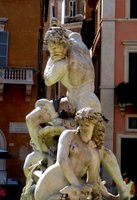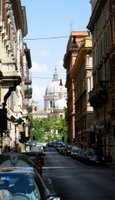August 12 - It is nearly noon by the time luggage is harpooned off the carousel and well past noon by the time we check into the hotel. We catch a glimpse of St Peter's (Bascilica San Pietro) winding our way to the hotel; that titillates. Drop our bags and hit the streets! Ah Sweet antiquity!

The Vatican is near our hotel but most of the Roman, Renaissance and Baroque structures are on the other side of the Tiber river so cross it we do.
 Almost immediately we pass into Piazza Novona, perhaps Rome's most famous Baroque site, a huge piazza built upon the ruins of Emperor Domitia's Circus Domitianus dating from early empire days. In the 17th century the piazza was rebuilt in accordance
Almost immediately we pass into Piazza Novona, perhaps Rome's most famous Baroque site, a huge piazza built upon the ruins of Emperor Domitia's Circus Domitianus dating from early empire days. In the 17th century the piazza was rebuilt in accordance with Baroque design, in great part those of Bernini, most particularly around the central obelisk, an early Roman copy of a yet earlier Egyptian work. That, together with Bernini' famous sculptured fountain the Fontana dei Fiumi (1651) form the pinnacle central piece of this grand yet warmly human piazza.
with Baroque design, in great part those of Bernini, most particularly around the central obelisk, an early Roman copy of a yet earlier Egyptian work. That, together with Bernini' famous sculptured fountain the Fontana dei Fiumi (1651) form the pinnacle central piece of this grand yet warmly human piazza.At distance in the north end is the Fontana di Nettuno with its striking (literally) statue of Neptune and the Neraids. To the south, balancing the piazza, is the Fontana del Moro (the Moor).

Down another short serpentine street from the Piazza we break into openness, the apron approach to the grand, yet deceptively subdued portico to the Pantheon (All Gods), a bare hint of the majesty within. Entry to this strangely sombre yet light drum and dome delivers us a collosal culture jolt. Possibly the best preserved of all ancient Rome's public buildings, the Pantheon pays respects to all the gods. In reply all the Gods, it seems, and father time, have paid their respects to its altars, frescos, statues and otherworldly dome. It has a harmony and eternal majesty about it that strikes us each deeply.
Diving back in the crooked lanes of Rome we move on to another spectacle. This time the Fontana dei Trevi, a place of near archetypal significance to  a lad whose earliest movie memory may have been "Three Coins in a Fountain". But, alas, the movie bested reality - only because the swarms of tourists, each one seeking happiness, made the experience somewhat sad. We move on, leaving Trevi, the end point of Agrippa's 19 BC great roman aqaduct, to the vast number of others.
a lad whose earliest movie memory may have been "Three Coins in a Fountain". But, alas, the movie bested reality - only because the swarms of tourists, each one seeking happiness, made the experience somewhat sad. We move on, leaving Trevi, the end point of Agrippa's 19 BC great roman aqaduct, to the vast number of others.


Next stop is Rome's famous gathering place, Piazza di Spagna, the Spanish Steps. Its side streets are populated with upper-end shops which brings out the diva in Felicity. After too many pictures, now jet-lagged, foot-weary and culture shocked, we plunge back in to the close streets for one last stop.
 a lad whose earliest movie memory may have been "Three Coins in a Fountain". But, alas, the movie bested reality - only because the swarms of tourists, each one seeking happiness, made the experience somewhat sad. We move on, leaving Trevi, the end point of Agrippa's 19 BC great roman aqaduct, to the vast number of others.
a lad whose earliest movie memory may have been "Three Coins in a Fountain". But, alas, the movie bested reality - only because the swarms of tourists, each one seeking happiness, made the experience somewhat sad. We move on, leaving Trevi, the end point of Agrippa's 19 BC great roman aqaduct, to the vast number of others.

Next stop is Rome's famous gathering place, Piazza di Spagna, the Spanish Steps. Its side streets are populated with upper-end shops which brings out the diva in Felicity. After too many pictures, now jet-lagged, foot-weary and culture shocked, we plunge back in to the close streets for one last stop.

That is the Piazza Del Popolo, the people's plaza, the northern gate to the ancient City of Rome. It is not just the arch but the fountains, the ghost of Nero, the Egyptian obelisk from - get this- the 13th century B.C. all within the piazza design of Napolean's architect, early nineteenth century!

Facing this fascinating and beautiful melange are twin baroque cathedrals, each loaded with precious art, artifact and history. We stumble by, returning to our hotel for food and then sleep.
Beautiful sleep!





1 comment:
hey dad,
this is wonderful, keep it up... oh, and next time, I want to see some pictures!
love felicity
Post a Comment